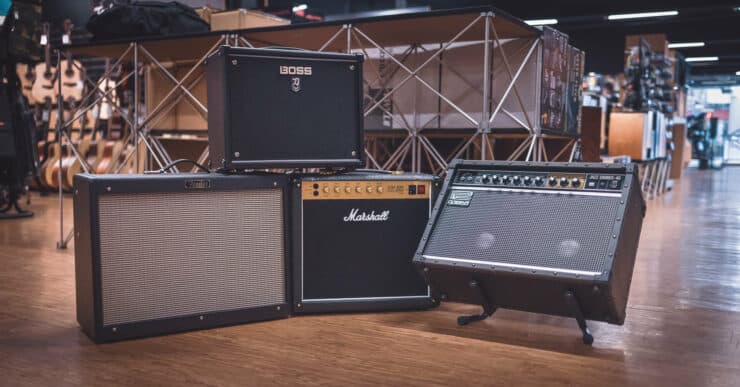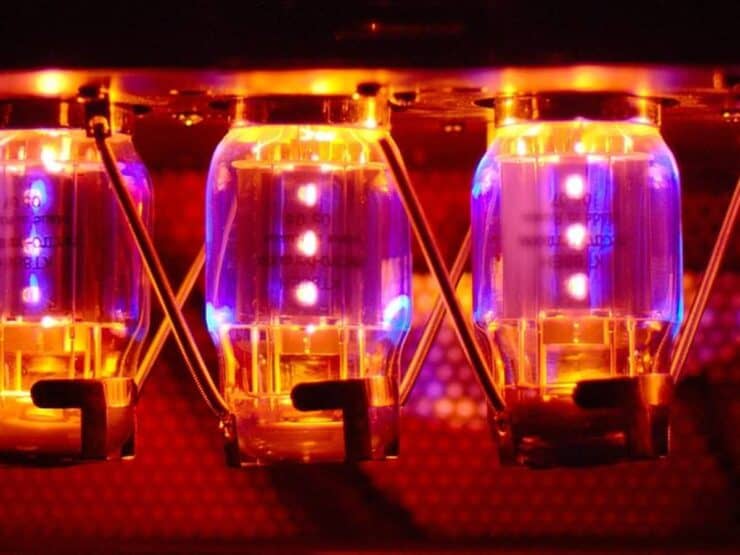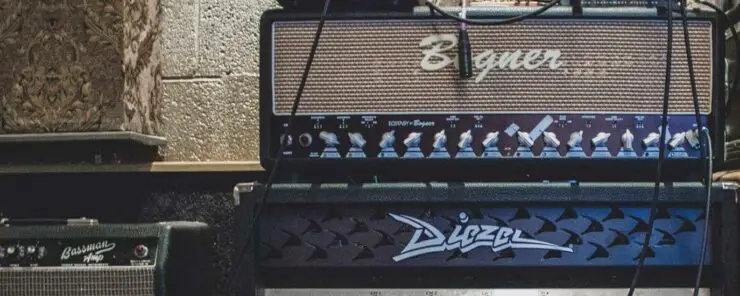Are you a guitar player who has been wondering about the comparison between tube and digital amps? Look no further! In this article, we’ll take a deep dive into the differences between the two, so you can decide which one is best for you. From sound quality and reliability to price and maintenance, we’ll cover all the essential points. So, if you’re ready, let’s get started!
What are tube amps?
When it comes to audio amplification, tube amps hold a special place in the hearts of musicians and guitarists. These amps utilize vacuum tubes or valves to amplify sound signals. Tube amps are known for providing wonderful warmth, richness, and dynamic tone, which makes them highly sought after in the world of audio.
A tube amp, short for vacuum tube amplifier, is an electronic amplifier that makes use of vacuum tubes for amplifying electric signals. It consists of various components that work together to amplify and shape audio signals, delivering a distinctive sound characteristic of tube-based technology. Unlike solid-state amps that use transistors and integrated circuits, tube amps produce a warm and smooth sound that many musicians and guitarists find pleasing to the ear.
>>> Click here to read our review about the Top 15 Best Tube Amps <<<
Here are the different components of tube amps –

#1. Vacuum tubes
Vacuum tubes are the heart and soul of a tube amp. These glass-enclosed electronic components house heated cathodes, anodes, and control grids. The most common types of vacuum tubes found in tube amps are triodes, tetrodes, and pentodes. The tubes play a key role in amplifying the audio signal and adding their unique sonic signature to the output.
#2. Transformers
Transformers are key components in tube amps, as they allow for impedance matching and voltage amplification. There are two primary types of transformers found in tube amps – power transformers and output transformers. Power transformers step up or step down the incoming voltage to the ideal level for the amp’s operation. Meanwhile, output transformers match the high-impedance output of the tubes to the low-impedance speakers.
#3. Capacitors
Capacitors are tasked with filtering and coupling the audio signal within a tube amp. They store and release electrical energy, allowing the amp to operate smoothly and prevent any unwanted noise or distortion. Capacitors are commonly found in various locations within the circuit, such as the power supply section and the tone control circuitry.
#4. Resistors
Resistors are passive electronic components that limit the flow of charge within the amp. They are used for biasing the tubes, setting proper voltages, and providing stability to the amp’s circuit. Resistors play a key role in determining the overall gain, tone, and response of the tube amp.
#5. Preamp stage
The preamp stage prepares the incoming audio signal for amplification by boosting its voltage and applying tonal shaping. Typically, it consists of one or more tubes alongside associated resistors, capacitors, and additional tone control circuits. The preamp stage plays a key role in shaping the overall sound and can greatly contribute to the unique tonal characteristics of a tube amp.
#6. Output stage
The output stage of a tube amp is responsible for driving the speakers and producing the final amplified sound. It consists of output tubes, output transformers, and coupling capacitors. The selection of output tubes and output transformer design has a major influence on the tonal characteristics and power output of the amp.
What are digital amps?
Although tube amps remain particular fan favorites of musicians and guitarists, digital amps have also gained popularity thanks to their efficiency, compactness, and versatility. Unlike their analog counterparts, digital amps make use of Digital Signal Processing (DSP) technology for amplifying sound signals. These amps convert analog audio signals into digital signals, process them using different algorithms, and convert them back into analog signals for output.
A digital amp or also known as a digital modeling amplifier or class D amplifier is an electronic device that makes use of digital signal processing and switching amplification technology to amplify audio signals. Digital amps operate by rapidly switching the input signal on and off at high frequencies, resulting in efficient power conversion and minimal energy loss. They offer numerous advantages, such as compact size, high-power efficiency, the ability to produce accurate and detailed sound, and more.

Here are some of the primary components of digital amps –
#1. Analog-to-digital converter
An analog-to-digital converter (ADC) is responsible for converting analog audio signals into a digital format that can be easily processed by the digital amp. It will sample the incoming analog signal at regular intervals and converts it into a series of binary numbers that represent the audio waveform.
#2. Digital Signal Processor (DSP)
The Digital Signal Processor or DSP is essentially the brain of a digital amp. It performs many different mathematical calculations and algorithms to process and manipulate digital audio signals. The DSP can easily control the amp’s gain, equalization, frequency response, and other audio processing functions, allowing for precise control and customization of the sound output.
#3. Digital amplification stage
The digital amplification stage is where the amplification of the digital audio signals actually takes place. It utilizes Pulse Width Modulation (PWM) or Pulse Density Modulation (PDM) techniques for converting the processed digital signals into high-frequency electrical pulses. These pulses are amplified by power transistors or switches, driving the speaker output.
#4. Input and output connections
Digital amps feature different input and output connections for accommodating different audio sources and speaker configurations. The common input connections include analog audio signals (like RCA or XLR) and digital audio inputs (like coaxial or optical). Output connections consist of speaker terminals or binding posts for connecting the speakers.
#5. Output stage
The output stage of a digital amp is tasked with driving the speakers and producing the final amplified sound. It comprises power transistors or switches that receive the amplified digital pulses from the digital amplification stage. These transistors switch on and off rapidly for creating the audio waveform, which is then passed to the speakers.
#6. Control interface
Digital amps typically include a control interface for adjusting different parameters and settings. This interface can be in the form of buttons, physical knobs, or a digital display. This allows the users to easily control volume, tone adjustments, input selection, and other audio settings.
How do tube amps compare to digital amps?
When it comes to choosing an ideal tube amp, one of the key considerations will be the type of amp that best suits your needs and preferences. Two popular options are tube amps and digital amps. Each one of them comes with its own distinct characteristics and advantages. However, they are different from one another to an extent. This is why you will want to know how do tube amps compare to digital amps. Here is how the two types of amps compare against each other –
#1. Tone
Tube amps are known for their warm and organic tone. The inherent characteristics of vacuum tubes in tube amps contribute to a smooth and harmonically rich sound. Tube amps are often preferred by musicians and guitarists who are looking for the classic, vintage tone that they deliver. The natural compression and harmonic distortion of tubes add depth and character to the sound, especially when driven at higher volumes.
Digital amps have certainly come a long way in terms of tone and sound quality. With rapid advancements in digital signal processing technology, many digital amps can accurately model the characteristics of tube amps, solid-state amps, and more. Moreover, they also offer a wide range of tonal options. They can simulate various tube types, speaker cabinets, and even room acoustics. Further, digital amps also offer versatility and the ability to reproduce different tones, from clean and pristine tones to heavily distorted ones.
While digital amps have definitely made great strides in emulating different types of amp tones, musicians and guitarists still prefer the authentic and organic sound of tube amps.
#2. Dynamics
Tube amps are known for their dynamic response. They excel when it comes to capturing the subtleties and nuances of a player’s touch and technique. When played softly, tube amps can produce a clean and delicate sound. Meanwhile, digging into the strings or hitting them harder will result in a natural and musical breakup. The dynamics and responsiveness of tube amps make them highly expressive and ideal for music genres like blues and rock.
Digital amps can provide an excellent dynamic range, especially with the latest advancements in modeling technology. They offer precise control over dynamics courtesy of digital signal processing. However, some may argue that digital amps lack the natural, organic response and subtle variations in dynamics that only tube amps can offer.
Tube amps are typically considered to be better as they have a more natural and responsive dynamic range. Moreover, they also provide a more interactive and expressive playing experience.
#3. Reliability
Tube amps consist of fragile and sensitive vacuum tubes that require occasional maintenance and replacement. Tubes will inevitably wear out over time and their lifespan will depend on factors like usage, operating conditions, and quality. Moreover, tubes are also susceptible to damage from shocks and vibration. With proper care and maintenance, tube amps could last for many years.
Digital amps are typically more reliable and durable. They are less susceptible to wear and tear while not being as sensitive to external factors like vibrations. Digital amps offer consistent performance and can operate reliably for extended periods without the need for tube replacements or other maintenance.
Ultimately, digital amps are considered to be more reliable and need less maintenance compared to tube amps.
#4. Cost
Tube amps can be relatively expensive because of the cost of vacuum tubes and the labor-intensive manufacturing process. Additionally, vintage or high-end tube amps can be quite pricey. Further, the cost of maintaining and replacing tubes will add to the overall expense of owning a tube amp.
Since digital amps are based on solid-state technology, they tend to be much more affordable. The mass production of digital components and integrated circuits makes them cost-effective to manufacture. Digital amps also offer a wide range of price options, from budget-friendly options to high-end models having advanced features.
Digital amps are considered to be more budget-friendly, which makes them accessible to a wider range of users. Meanwhile, tube amps tend to be more expensive, especially when you factor in ongoing tube replacements.
Pros and cons of Tube Amps
As mentioned above, tube amps are quite popular among musicians, guitarists, and audio enthusiasts. These devices are capable of providing a great, warm and distinctive tone that has been cherished in the music industry for decades. However, like any other technology, tube amps also come with a set of pros and cons. Here, you will get to know the positives and the potential negatives associated with tube amps.

The pros of tube amps are –
#1. Vintage tone
Tube amps are highly revered for their unique and warm sound signature. The natural compression and harmonic distortion produced by vacuum tubes add to the depth and character of the audio. This makes them particularly well-suited for music genres like jazz, blues, and classic rock. Many musicians and guitarists find that tube amps provide a much more organic and pleasing tonal response.
#2. Dynamic range
Tube amps are highly responsive to the player’s touch and technique. These devices excel at capturing the subtleties and nuances of playing, offering a wide dynamic range. Tube amps offer an expressive and interactive playing experience, responding to changes in playing style and volume with finesse.
#3. Harmonic saturation
Vacuum tubes generate harmonic overtones as they approach their maximum output levels. This natural saturation creates a pleasing distortion commonly known as “tube breakup”. Many musicians and guitarists appreciate this harmonically rich and dynamic sound, as it adds character and depth to their playing or audio-listening experience.
#4. Aesthetics and collectability
Tube amps have a timeless and vintage charm about them that appeals to many collectors and music enthusiasts. They often come in retro designs, visible glowing tubes, and sturdy construction. Tube amps are also sought after by collectors and musicians who appreciate their classic appeal and historical significance.
The cons of tube amps are –
#1. Maintenance and fragility
Tube amps require regular maintenance and care. Vacuum tubes are delicate and can gradually wear out over time, requiring immediate replacements. Moreover, tubes are also sensitive to vibration and shocks, which can result in damage. Occasional tube replacements, periodic servicing, and proper handling will be necessary to maintain optimal performance.
#2. Weight and size
Tube amps tend to be larger and heavier compared to digital and solid-state amps. The inclusion of bulky transformers, large chassis, and multiple tubes contribute to the substantial weight. This can be a particular disadvantage for musicians or audio professionals who need portability or have limited space.
#3. Excessively high costs
Tube amps can be more expensive compared to digital and solid-state amps. The manufacturing process, high-quality components, and the inherent labor-intensive nature of tube amp construction contribute to the high price tag. Moreover, the added cost of tube replacements will add to the overall expense of owning and maintaining a tube amp.
#4. Limited features and connectivity options
Tube amps typically offer fewer built-in features and connectivity options compared to digital amps. They typically focus on delivering the core amplifier functionality without extensive built-in effects or digital processing capabilities. This may not be a drawback for purists who are looking for simplicity, but it can limit the versatility for musicians who need a wide range of effects and tonal options.
Pros and cons of digital amps
Digital amps are also quite popular among musicians and guitarists, although not as much as tube amps. These electronic devices are capable of offering a wide range of features and benefits that appeal to musicians, guitarists, and audio enthusiasts, such as versatility, more built-in effects, less maintenance, and more. However, they aren’t perfect, and they still have a fair share of potential disadvantages. Here are the positives and potential negatives of digital amps that you must know about.
The pros of digital amps are –
#1. Efficiency
Digital amps are highly efficient when it comes to power usage. They can easily convert the incoming audio signal into a digital format, process it via algorithms, and convert it back into an analog signal for output. This conversion process will allow the digital amp to minimize energy loss and deliver high-power efficiency. As a result, they produce less heat and consume less power compared to traditional analog amplifiers.
#2. Compact and lightweight
Digital amps are typically smaller and lighter compared to their analog counterparts. The compact size and lightweight design will make them more portable and convenient for musicians and audio professionals who need mobility or have limited space. Digital amps are perfect for rehearsals, gigs, or studio setups that demand easy transportation.
#3. Versatility and flexibility
Digital amps offer a wide range of features and functionalities. These features will allow you to experiment with different tones, effects, and amplifier simulations without the need for additional equipment. Digital amps offer greater connectivity options, including Bluetooth, USB, and digital inputs. This makes them compatible with various devices and modern audio setups.
#4. Consistent performance
Digital amps are capable of providing consistent performance across different environments and operating conditions. They are less susceptible to factors like temperature changes, component aging, and voltage fluctuations, which can greatly affect the performance of analog amps. This reliability will ensure that your digital amp is capable of delivering consistent sound quality and performance over extended periods.
The cons of digital amps are –
#1. Sound reproduction is not ideal for purists
Even though digital amps have significantly improved in terms of sound quality, many purists argue that they still lack the warmth and natural character of tube amps. While digital signal processing can help replicate a variety of tones and effects, some listeners can still notice a subtle difference in the overall sound and feel compared to traditional analog amps.
#2. Complexity and learning curve
Digital amps come with a wide range of features and controls. This can make them more complex to operate, especially for beginners. Understanding and navigating through different settings, menus, and options might require a steep learning curve. However, you can overcome this with time and familiarity with the amp.
#3. Reliance on technology
Digital amps rely heavily on digital processing and integrated circuits. If any component within the digital circuitry fails or malfunctions, it can greatly affect the overall performance of the amp. This dependence on technology might require professional repair or replacement of digital components in cases of failures. This can be quite complicated compared to the maintenance of analog amps.
#4. Potential for obsolescence
With advancements in technology, newer digital amp models with better features and improved sound quality continue to emerge. This rapid progression might result in older digital amps becoming outdated or replaced by newer iterations. This can potentially affect their resale value and compatibility with future audio systems.
FAQs
What are the main differences between tube amps and digital amps?
Tube amps use vacuum tubes to produce sound, while digital amps use digital processing to create sound. Tube amps are known for their warm, organic tone, while digital amps provide a more precise sound with a wide range of effects and tones. Tube amps are also known for their dynamic response and ability to distort, while digital amps are more consistent with how they sound.
What are the advantages and disadvantages of tube amps?
The main advantage of tube amps is their warm, organic sound, which is often preferred by many guitarists. They also have a dynamic response and can distort in a pleasing way. However, they require more maintenance and can be expensive.
What are the advantages and disadvantages of digital amps?
Digital amps are known for their versatility, as they can create a wide range of sounds and effects. They are also more consistent and require less maintenance than tube amps. However, they may not provide the same warmth and dynamic response as tube amps and may not have the same classic amp tones.



